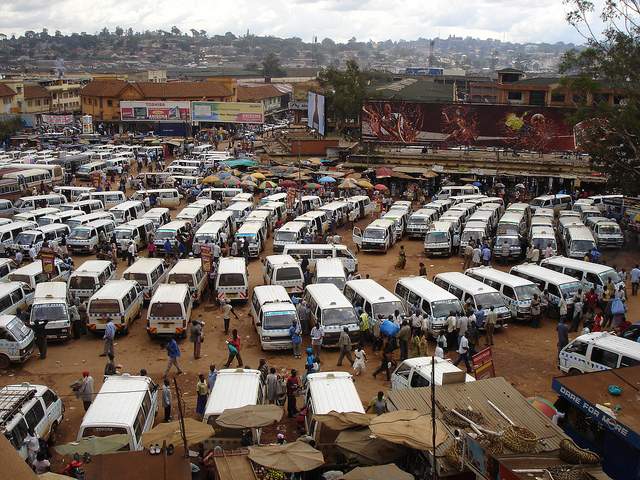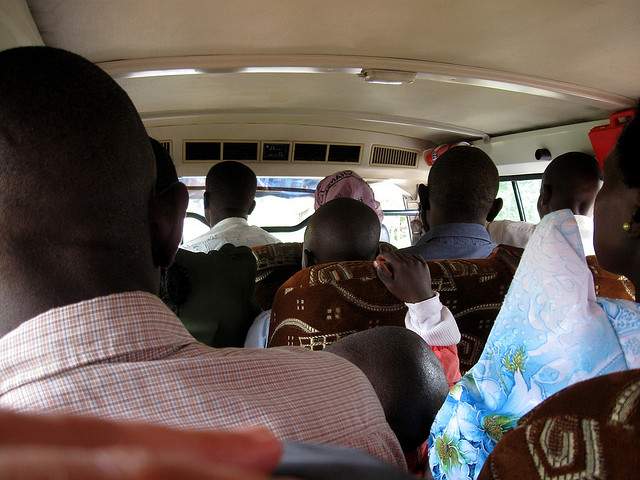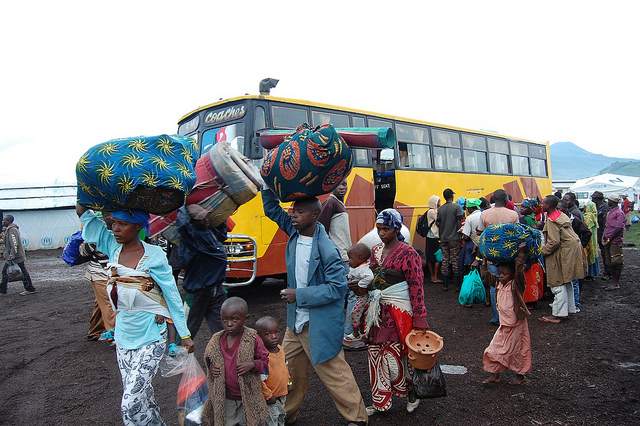Part of the “fun” of long-term travel is traveling overland. Slow travel allows you to dig into a culture and learn more about it. And traveling by bus, train, minibus, boat, etc. creates all types of learning opportunities. It also creates some of the best stories.
Overland travel in Africa is not for the faint of heart, and if you are brave enough to do it, you’ll come out of it a better, more patient traveler with a multitude of hilarious stories to tell.
The following stories and tips are specific to an experience with public transport in Uganda, but most can be applied to overland travel in any developing country around the world.
A taste of public transport in Uganda

My local friend and traveling companion, Robert, said, “We should go over some things before our trip.”
I figured he referred to time tables or confirming costs or other logistics. It was going to be my first experience with long distance public transportation in Uganda, which involves minivan taxis and full-size tour buses.
“First of all,” he said, “can you afford not to use the bathroom for the whole day?”
“What?” This wasn’t what I had expected to come from his mouth.
“There will be no place to go during the trip. So can you afford 7 or 8 hours?”
Honestly, I quite doubted it. But I wasn’t going to cancel the trip to Fort Portal on this account, though my mind filled with extremely unpleasant images of sitting in a puddle of pee beside Robert who would have disowned me, laughing derisively along with everyone else at the disgusting mzungu, our friendship broken, flies swarming menacingly around me and my foul odor. Thankfully forewarned, I refrained from breakfast, took only enough water to swallow my daily pills, and squeezed every drop I could from my bladder before leaving.
I’d had the bad luck of waking up that day feeling ill. I felt worse by the mile as we rode for over an hour in a taxi from Entebbe to Kampala. Once Robert secured us seats on a bus in Kampala, we were marooned there in the bus park for a couple more hours. I felt more nauseous by the minute. I asked Robert if he would be totally embarrassed if I puked out of the window. I was hoping for a rub on the back and “of course not.” But he went with brutal honesty, “Yes.”
“Can I get off the bus and go somewhere to get sick?”
“There is nowhere to go.”
No peeing, pooping, or puking … for who knew how many more hours. When I told Robert I had ridden a bus in Peru that had a toilet inside it, he was stupefied.
“In the bus?”
“Yep.”
“I can’t believe it!”
Tip #1: Don’t eat or drink more than you can afford to keep in long-term intestinal storage.
This trip to Fort Portal was nearly 8 hours. On a trip I later took from Kabale to Entebbe, I had to endure 14 hours without showing my buttocks the light of day.
A corollary tip: If the bus driver ever makes a stop in the middle of nowhere and half the people depart the bus and sprint into the bushes, this is your opportunity for a restroom break. Again, Robert was invaluable in clueing me in. As the bus slowed down, he said, “OK, luckily the driver is stopping if you need to relieve yourself. Can you afford to use the bushes?” He was always concerned that I couldn’t deal with primitive conditions in Uganda.
“Yes, that’s fine, no problem.” My morning meal abstinence had been disappointingly ineffective. Also this was my chance to empty my stomach as well, if necessary.
“You’re sure?”
[social]
As soon as the bus door opened, I joined the stampede and sprinted toward some bushes. Besides being the only mzungu (white person), I was also the one girl without a skirt on … my modesty was a bit more compromised than that of the other ladies. But so what; about the only more welcome pee break I ever had was after being lost in the medina in Tunis. Thankfully, my stomach was feeling more stable by now and I was able to sprint back to the bus along with everyone else.
In terms of finding the bus in the first place, I am in debt to Robert who dragged me, quite literally, in my ill state through the mayhem of the Kampala bus park. Had it not been for him, I’m confident all of my luggage would have been wrested away from me, and I would have simply sat down on the sidewalk, overwhelmed, and cried.
Tip #2: If you utilize the Kampala bus park or taxi park, hold your luggage close and tightly.

Particularly as a mzungu, you’ll be walking through a forest of hands reaching out to grab your bags in order to lead you to a particular bus like a horse with reins. Ignore the similar swamp of voices demanding your destination; if you answer an inquiry into your destination, you’ll have forfeited your free will and be man-handled toward a bus with that stop. There will be several different companies servicing the same city, so you can ask to first look inside a bus before buying a ticket to ensure there are adequate seats available.
Tip #3. You can actually talk your way into a window seat when boarding a full minivan taxi.
If you’re at all claustrophobic, I can’t recommend this more highly. It helps if you can have a local acquaintance present your case and convince the conductor to make a row of people get out so you can crawl in beside the window. A taxi might look tolerable when you first get in, but it will get worse. It can always get worse, no matter how sure you are that it can’t. The stories of 25+ people in a minivan are true.
Tip #4: Carry nothing you might wish to access during the journey in your pockets.
You may not be able to squeeze your hand into them for retrieval. One time I had put my MP3 player in my front pocket; I had imagined accessing it during the ride. The folly was soon obvious. The player began poking into my leg, and undoubtedly the kid’s leg next to mine. I tried to squeeze my hand between our legs to extract it, but after about 10 minutes of effort, I settled for a slight relocation within the pocket. I know the kid wished me success in my procedure, but he couldn’t budge the two passengers and the conductor on the other side of him to free up some space between our legs.
After this episode in the taxi, I removed my MP3 player for the upcoming bus ride. I thought I had everything under control now; put my hanky through my belt buckle (as there is no AC, I much preferred looking like a dork to sweating like a pig with no mopping device). But I put my bus ticket in my back pocket after purchasing it. When the conductor came around to collect tickets, I couldn’t get my hand anywhere near my pocket, let alone inside it. After the conductor watched me struggle for awhile, finally he said, “It’s OK, I can see your predicament.”
I had boarded this bus in the middle of its route. The conductor misjudged the available seats and I ended up the last person without one. His keen eye spied a “space” on the last row in the dead middle.
“Make way for the mzungu!” he shouted, pushing me down the aisle as I held my oversized daypack and satchel. He turned me around and shoved me by the shoulders, forcing me into that space. There was no place for my pack, only a small space on the shelf above for my satchel, which I had not wanted to part with.
Tip #5: Carry minimal luggage in sizes small enough to fit on your lap; you may well be holding it there.

It was quite a heavy thing, my pack, with hiking boots, books, clothes, cameras. Its length exceeded the length of my thighs, which were sloping down because my feet couldn’t quite touch the ground. My legs soon went numb, my arms ached from holding that blasted pack on my lap. Why couldn’t I just put it on the floor at my feet? you ask. Because that space was filled with children sitting with their backs against my shins. So I also had to keep my pack from sliding off my lap onto their heads.
The woman beside me on the left had been holding a toddler the whole time. A woman two people over on my right, also holding a child, stood up at her stop and extracted herself with Herculean effort from the back seat into the aisle. She held out her free arm and the woman on my left handed her the little boy. With a child in each arm and a bag around her neck, she exited the bus. I was confused because the woman beside me remained. I looked over at her, concerned she had missed her stop. “Freedom!” she exclaimed to me. The child wasn’t even hers.
Tip #6. Be prepared to hold strange children on your lap and let them sit on your feet.
A child’s bus ticket apparently doesn’t entitle them to an actual seat. On another trip, riding in a taxi for several hours, there were four children in the front seat. Two sitting and one on each of their laps. When the lap-sitters disembarked, again to my surprise, the other two children stayed aboard. Bless their hearts, even children have to hold strange children on their laps.
Tip #7: Be fit enough to power your way down the aisle.
The aisles can be full of adults without seats, sleeping children, jerry cans of all sizes, branches of bananas, and sacks of cassava. Bus drivers will go on for miles past your stop with a deaf ear to your cries until you can make it to the door. I witnessed this numerous times. One poor lady could not wade her way through from the back for anything. She was shouting and waving a chubby hand, and the bus kept going. Soon half the bus was shouting for the driver to stop. He kept on driving until she was finally pushed and pulled by the other passengers to the door, her turquoise dress crumpled and misshapen, her woven handbag falling off her shoulder, at least three miles down the road from her stop.
Next are a couple of tips on comfort.
Tip #8: Don’t sit near the front.

I know my friend Mathius thought he had secured a premium seat for me on the long ride from Kabale to Entebbe in the front row, where I had perfect sight out the windshield. It was nice for sightseeing, but I was also privy to the driver’s tailgating methods … employed even after we passed an overturned bus on the side of the road with scores of miserable-looking passengers huddled around. Also, I could have done without the knowledge that the driver was a homicidal maniac. Fortunately he was having a bad day, and no one was killed. He literally drove straight at the vendors on the side of the road in a game of chicken until at the last second, the poor wide-eyed vendors went sprinting and diving to the side as he plowed through them to a stop.
Tip #9: Consider buying a pair of padded pants such as the Pilko Pump Pants
Seats are often little more than a fabric swatch sandwiched between a board and a plastic slip cover. I’m being a little facetious with the Pilko Pump Pants, though in all honesty, it’s not a bad idea. One kid on a long taxi ride sat on the only piece of luggage he had with him: a pillow. I was so covetous of this comfort, I could feel saliva accumulating in a reservoir at the corner of my mouth in preparation for a bonafide drool.
Tip #10: When taking long-distance public transportation, do not arrange a time for someone to pick you up at your destination until several hours later than you might hope to arrive.
That 14-hour feat of bladder control I pulled off was never estimated for me to be anywhere near 14 hours. Mathius mentioned 8 or 9 hours. One of the biggest problems is that buses and taxis don’t leave until they’re full. For a minivan taxi it might not take so long, depending on how popular your destination is. For a full-size long-distance bus; however, you can sit in a bus park for hours before the conductor is satisfied.
Tip #11: Sometimes it’s best simply to bypass public transport methods altogether.
Long-distance transportation infrastructure is seriously lacking in Uganda. The buses and taxis mainly ply only the handful of primary highways. Without personal transport (referred to as “special hire” in Uganda), it can be a bit brutal to get to some of the tourist sights a little further in, as you’d need to hitchhike in a country with few privately-owned vehicles that aren’t safari company-owned or pre-stuffed with the driver’s friends. Many tour companies have policies not to pick up hitchhikers with clients in the vehicle. So at times, a private driver is, in my opinion, well worth the high price. I did this for several days to access Queen Elizabeth National Park. I liked my driver, and I continued to gain insights into the culture from extensive personal conversation.
Tip #12: Use the boda boda.

The most popular form of transport is the motorcycle taxi. It can be expensive, so it’s not practical for any significant distance. But for getting around locally, it’s unquestionably the way to go. If the driving makes you nervous, just hold on tight and close your eyes. I’m a motorcyclist myself, so I wasn’t much bothered. If you think you are carrying too much with you for a motorcycle, boda drivers will beg to differ. One evening I was waiting by the side of the road in Kampala for a friend to pick up me and some supplies. Boda after boda stopped to offer transport for a carry-on size suitcase, a large daypack and a satchel, one large branch of a banana tree loaded with bananas, a huge burlap sack of potatoes, a two-foot-high mound of green onions, a bag of mangoes, and a 120-pound girl. They’re brilliant.
It’s true I spent some miserable moments aboard Uganda’s public transportation, but those experiences will make me a better traveler next time. Somebody asked me a great question the other day … could I have bought up all the remaining seats on a bus myself to hasten the departure? If 40 tickets need to be sold before the bus will depart, could I have bought the last 10 for myself just to get the stupid thing to hit the road? I personally don’t know the answer to this, but I will investigate the next time I’m in Uganda. Some things are worth a little extra money.
Read more about overland travel:
- Overland Travel in Africa and the Middle East
- Overnight Bus Tips from an Expert
- Overland Travel on Your Long-Term Trip
- A Step-By-Step Guide to Riding the Chicken Buses of Guatemala
- How to Travel Long Distance By Bus
Bio: Shara Johnson lives in the Colorado Rocky Mountains. Her primary occupation is dreaming of where to travel to next. She writes literary essays and exhibits travel photography. You can follow her narrative travel blog on SKJtravel.net.
Photo credits: misssharongray, adam coster, Simisa, Daryona, DFID
